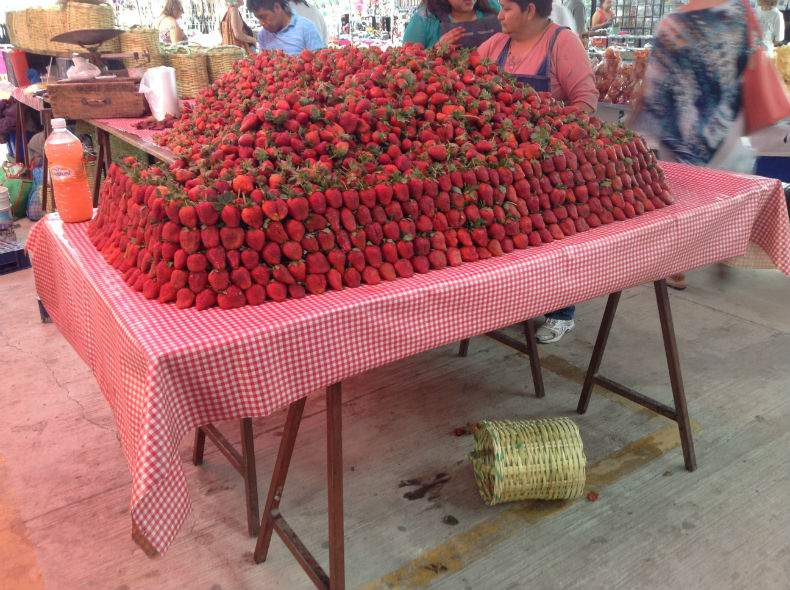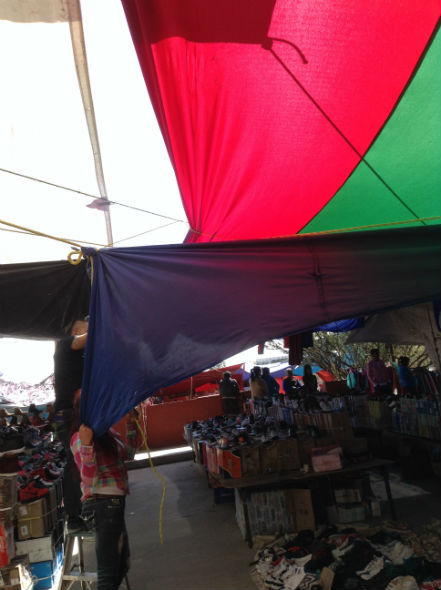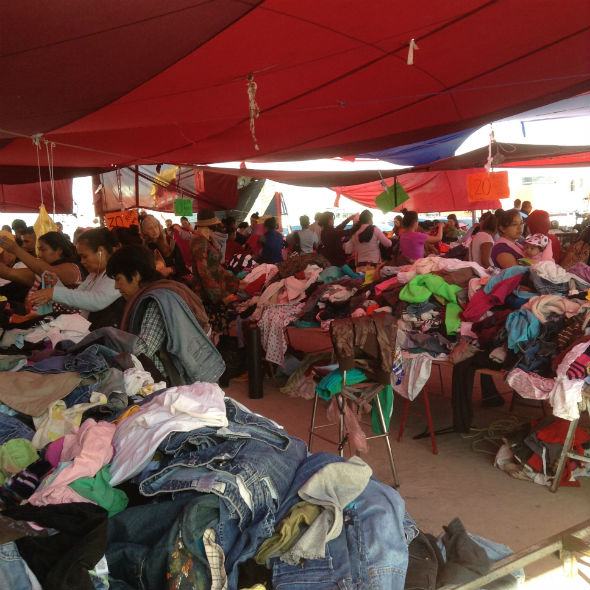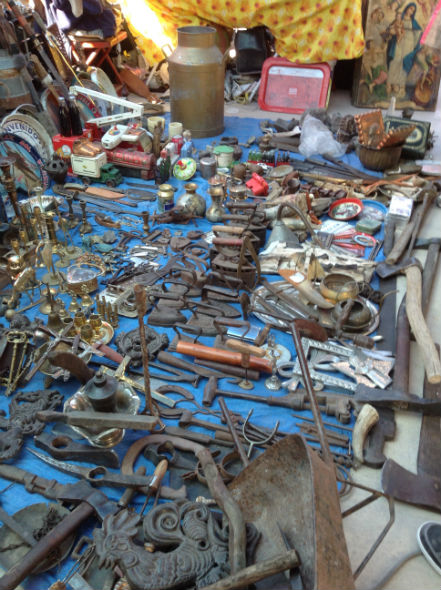
by Isobel Cunningham
Everyone talks about it. It is the source of bargains and “an experience”. It is held far from the well-trodden streets of the town, far from the familiar main square and the beautiful parish church of St. Michael. It is removed from the restaurants, cafes, bakeries, grocery stores and souvenir shops, the haunts of most visitors. It sits on top of a hill on the road out of town. It is huge. By magic every Tuesday it appears and every Wednesday it is gone.
Take the rattling bus from the central stop. The bus will be packed with people going up to buy food or clothes or any of a number of other things I cannot imagine needing. Move over. I’ll come with you. Everyone on the bus needs something, they want something. They want to find a bargain. Even you want that.

The bus stops on the wrong side of the highway so let’s follow the crowd over the footbridge that leads to the chaotic market grounds. By now you must be thirsty. Drink the water you so prudently brought with you or succumb to fruit or jugs of juice overwhelming in size and brilliant color. Do you dare to eat a slice of that watermelon? The table piled high with strawberries is a monument to red. God knows what time the seller got up to build such a step-pyramid of temptation? Brought a bag did you? We’d better buy onions, silvery and huge and garlic and broccoli emerald green or cauliflower or imposing leeks. We’ll need to cook something for supper, after all.

Need embroidery thread and stamped tablecloths to fill your spare time? An axe head perhaps or a pair of spurs? Lurid underwear or jeans? Do you need parts for a broken blender or pirated music tapes? Toys, a dress for first communion, soccer shirt knock offs? What about flower pots and fertilizer or a mysterious herbal remedy that will cure every illness you ever had, ever dreaded, ever imagined you might contract by eating market watermelon. Telephones, radios, clocks, old pieces of machinery thrown down on a blanket, some antlers, perhaps. Plates and cutlery and kitchen equipment to make preparing those vegetables you bought a snap? If you can imagine it and if you have some money, you can have it today.
But perhaps you can’t wait? You want to eat now? Blasting music and the cries of “Cheke-le” drown out the hiss of frying fish, the bang of the tortilla maker smashing down on a lump of dough. If you’re hungry, sit down here. At the linoleum-covered tables, a four-piece band accompanies a meal of red or brown soup served to solid Mexicans. Timid Gringos eat purple gorditos. Kids “help” or sit and play under tables loaded with second-hand clothes or shoes. A little boy approaches, selling something mysterious out of a plastic bag. I give him the equivalent of a dollar for the privilege of seeing that incandescent smile. I am none the wiser about his wares. He is no more than seven years of age and I keep an eye on him, feeling uneasy as a big man in leather boots approaches. No need to worry. He too digs into his pocket, gives the kid a few coins and sends him on his way.

Ah, girlfriend! Second-hand clothes! We plunge our hands into the multi-colored piles of women’s clothing and pull out blouses, pants, sweaters. We hold possible treasures up against each other and even try on some over our own clothes and then we spot the good stuff. Yes, even at the market there is an “upscale section”. Second-hand clothes from Gringas who live here permanently. Brand names in all the wrong sizes, all the wrong shades for our skin color, hair color, eye color. Do I want a butter yellow leather jacket for the equivalent of twenty dollars? You persuade me and ever after, it glows at me from a northern closet, often secretly caressed but seldom worn. Such are the Tuesday market bargains.
The wild spring wind picks up. The merchants have set up plastic sheets of bright orange or pink over their stalls and over the walkways between. They protect us from the sun but they make it impossible to distinguish the real color of the blouse, the towels, the tablecloth I am tempted to buy. Today the wind catches the sheets and they become the sails of a galleon skimming over the Sea of Cortez. The young men laugh as they clutch at the ropes holding the fluttering tarps. Two girls squeal as the thick plastic threatens to come down on their stall of counterfeit make-up. Here in the big Tuesday market is a face of Mexico.

Mexico of children, babies and school girls. Mexico of young mothers and old shawl-swathed grandmothers. Mexico of young men shaking hands with the aged guitar player. Mexico of hard work and of corruption. Mexico of hair smoothed back into a thick braid. Tawdry Mexico of a tinsel covered baby Jesus. Elegant Mexico of the cowboy. Toiling Mexico of the cleaning lady, of the bus driver. Mexico of Aztec dancers and First Communion class. Mexico of the church bell booming out over the square with no regard to the hour. Mexico of bougainvillea and of cactus of burned earth and of Coca Cola. Mexico of Guadalupe, Mexico of the frozen tears of the Virgin consumed as popsicles. Mexico of bull fights and pseudo-intellectuals. Mexico of artists and writers, good and bad. Mexico of the Federales with their big guns sitting to eat at a market table. Mexico of the mild stall keeper serving the food. Oh, Mexico, wait for us to come back.
We promise to come back next year to the Tuesday market. Once again we will get down from the high step of the rattling bus and climb aboard your magic galleon. Once again we will enter into this buzzing nest of buying and selling, of cooking and eating, of singing and listening. Full of dazzling sun, full of dust, full of hope and despair and enlivened by the wind that is the breath of some angel, Archangel San Miguel perhaps.
**************
 Isobel Cunningham lives in Montreal, Quebec, Canada. She writes poetry and fiction. Her book "Northern Compass," featuring poems on San Miguel, is available on Amazon.ca. She has attended three of the San Miguel Writers' Conferences and credits these experiences with allowing her writing career to bloom. She has been published on line by Silver Birch Press (poetry and fiction), Rat's Ass Literary Review (poetry) and The Lake (poetry). She is a docent at the Montreal Museum of Fine Arts and a contributor to the in-house docents' magazine.
Isobel Cunningham lives in Montreal, Quebec, Canada. She writes poetry and fiction. Her book "Northern Compass," featuring poems on San Miguel, is available on Amazon.ca. She has attended three of the San Miguel Writers' Conferences and credits these experiences with allowing her writing career to bloom. She has been published on line by Silver Birch Press (poetry and fiction), Rat's Ass Literary Review (poetry) and The Lake (poetry). She is a docent at the Montreal Museum of Fine Arts and a contributor to the in-house docents' magazine.
|